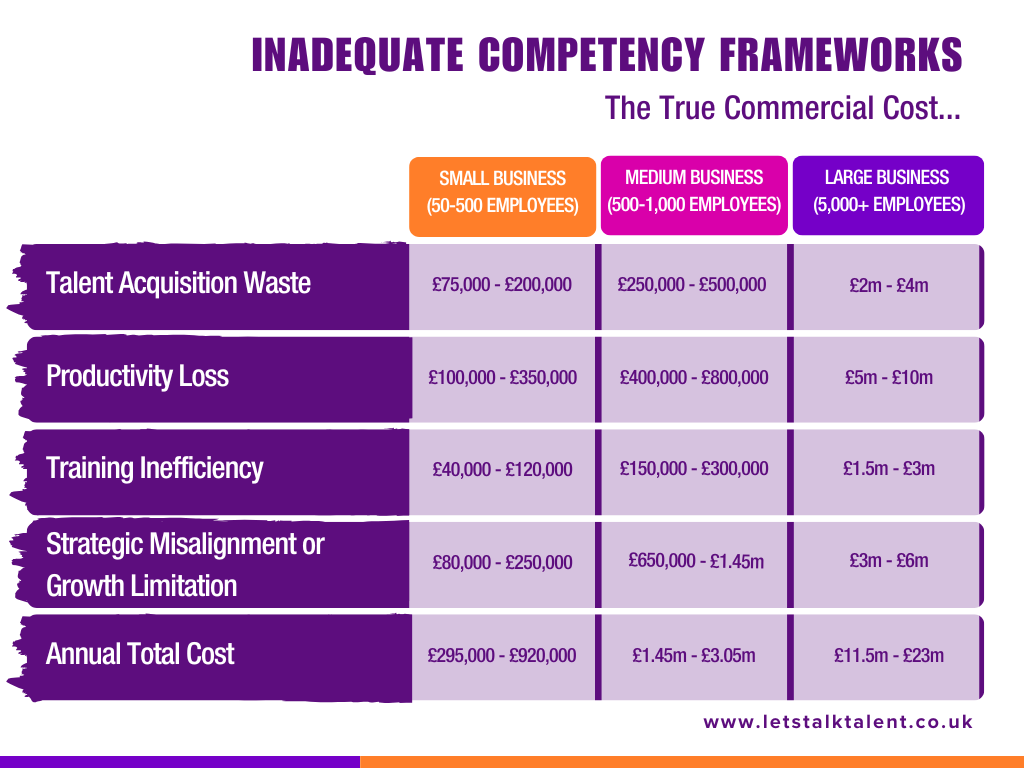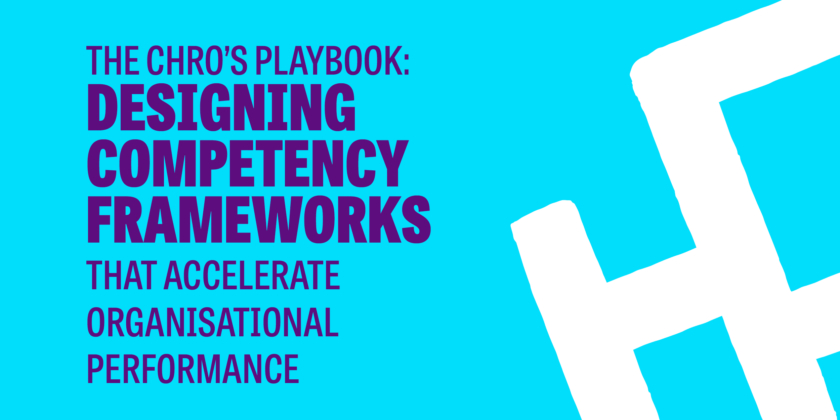The most successful companies don’t just manage talent – they invest in the right capabilities to increase profit, reduce churn, and accelerate growth. What if your competency framework was the single biggest lever for impacting your bottom line, reducing hiring costs, and improving workforce performance. But right now, where’s yours? Most likely it’s just sitting in a drawer, collecting dust.
In today’s rapidly evolving business landscape, the difference between thriving and merely surviving often comes down to one critical factor: your people. As a CHRO or HR Director, you’re tasked with not just managing talent, but strategically deploying it to drive measurable business outcomes.
At the heart of this challenge lies the organisational competency framework – a powerful yet often underutilised tool for transforming workforce capabilities into competitive advantage.
Why Traditional Competency Frameworks Fall Short
Research from Gartner reveals that 73% of organisations have competency frameworks in place, yet only 29% report these frameworks significantly impact organisational performance. This disconnect stems from a fundamental misalignment: too many competency frameworks are designed as HR tools rather than business accelerators.
“Most frameworks sit in drawers or on intranets, disconnected from daily work and strategic priorities,” notes the Harvard Business Review in their 2023 analysis of talent management practices.
The result? Wasted potential and frustrated executives who view HR initiatives as cost centres rather than value drivers.
The Commercial Cost of Inadequate Competency Frameworks
For senior leaders weighing investment decisions, understanding the true cost of inaction is crucial. Our analysis across organisations of different sizes reveals the financial impact of poorly designed or implemented competency frameworks:

For Small Businesses (50-500 employees):
- Talent Acquisition Waste: £75,000-£200,000 annually in recurring recruitment costs due to poor retention and misaligned hiring
- Productivity Loss: £100,000-£350,000 in opportunity cost from misaligned skills and competency gaps
- Training Inefficiency: £40,000-£120,000 in poorly targeted development investments
- Growth Limitation: £80,000-£250,000 in missed growth opportunities due to capability constraints
- Total Annual Cost of Inaction: £295,000-£920,000
For a Mid-Sized Organisation (500-1,000 employees):
- Talent Acquisition Waste: £250,000-£500,000 annually in recurring recruitment costs due to poor retention and misaligned hiring
- Productivity Loss: £400,000-£800,000 in opportunity cost from misaligned skills and competency gaps
- Training Inefficiency: £150,000-£300,000 in poorly targeted development investments
- Strategic Misalignment: £300,000-£650,000 in initiatives undermined by competency gaps
- Growth Limitation: £350,000-£750,000 in missed market opportunities due to capability constraints
- Total Annual Cost of Inaction: £1.45 million-£3.05 million
For Enterprise Organisations (5,000+ employees):
- Talent Acquisition Waste: £2-4 million annually in avoidable recruitment costs
- Productivity Loss: £5-10 million in unrealised performance potential
- Training Inefficiency: £1.5-3 million in suboptimal L&D investments
- Strategic Misalignment: £3-6 million in initiatives undermined by competency gaps
- Total Annual Cost of Inaction: £11.5-£23 million
These figures represent conservative estimates based on industry benchmarks, including the average cost-per-hire (£3,000-£30,000 depending on level), training investment per employee (£1,000-£2,500 annually), and productivity differences between top performers and average employees (typically 50-100%).
For smaller businesses, the relative impact can be even more significant, as each hire represents a larger percentage of the total workforce, and capability gaps can directly limit growth potential in ways that are proportionally more damaging than for larger organisations.
The Performance-Driven Competency Framework: A New Approach
Forward-thinking organisations are reimagining competency frameworks through the lens of organisational performance management. This shift involves three fundamental principles:
1. Start with Business Outcomes, Not HR Processes
Traditional approach: Defining competencies based on industry standards or best practices. Performance-driven approach: Working backwards from key business metrics and strategic priorities to identify the specific competencies that drive results.
Real-world impact: When global pharmaceutical firm AstraZeneca redesigned their competency framework with a focus on innovation metrics, they saw a 37% increase in successful product launches within 18 months.
2. Build Measurement into the Architecture
The old adage “what gets measured gets managed” applies powerfully to competency frameworks. Effective frameworks include:
- Clear KPIs that link competency development to performance metrics
- Regular assessment mechanisms that track progress
- Data integration with other business intelligence
- Dashboards that make competency gaps and improvements visible to leadership
A study by McKinsey found that organisations with metrics-driven competency frameworks are 2.5x more likely to see improvements in organisational performance compared to those with descriptive frameworks alone.
3. Design for Adaptability and Future-Readiness
Static competency frameworks quickly become obsolete. Progressive organisations are building adaptive frameworks that:
- Incorporate regular environmental scanning to identify emerging competency needs
- Use agile development methodologies to rapidly iterate and improve
- Include future-focused competencies that prepare the organisation for anticipated changes
- Balance core competencies with role-specific capabilities
How to Improve Organisational Performance Through Competency Frameworks
Translating these principles into action requires a structured approach:
Step 1: Map Your Performance Ecosystem
Begin by identifying the key performance indicators that matter most to your business. Whether it’s revenue growth, customer satisfaction, operational efficiency, or innovation metrics, these will serve as the north star for your framework.
Step 2: Conduct a Competency Impact Analysis
Which competencies have the greatest influence on your critical performance metrics? This analysis often reveals surprising insights – for example, many organisations discover that collaboration skills have a more direct impact on sales performance than traditional selling techniques.
As Helen Keller said “ Alone we can do so little, together we can do so much.”
Step 3: Design Your Measurement System
How will you measure both competency development and its impact on organisational performance? Effective systems typically combine:
- Self-assessments
- Manager evaluations
- Performance data analysis
- Customer feedback
- Peer reviews
Step 4: Create Implementation Pathways
Different teams and individuals will need customised development journeys which link to the same framework. Design clear pathways that connect assessment results to targeted development opportunities, whether through formal training, coaching, experience-based learning, or mentorship.
Step 5: Establish Governance and Evolution Mechanisms
Who owns the framework? How often will it be updated? What triggers a review? Answering these questions ensures your framework remains relevant and valuable over time.
The Business Impact: What Success Looks Like
When competency frameworks are properly aligned with organisational performance goals, the results can be transformative across multiple dimensions:
Financial Outcomes:
- Reduced recruitment costs through improved retention and internal mobility
- Faster time-to-productivity for new hires
- Higher revenue per employee as capabilities align with strategic priorities
Customer Impact:
- Improved satisfaction and loyalty metrics
- More consistent customer experiences across touchpoints
- Faster resolution of customer issues
Operational Excellence:
- Increased innovation and adaptability to market changes
- More efficient collaboration across teams and departments
- Reduced risk through improved compliance and decision-making
People Development:
- Clearer career pathways for employees
- More targeted and effective learning investments
- Higher engagement and retention of key talent
The organisations seeing the greatest success are those that continuously measure, refine, and evolve their competency frameworks based on changing business conditions and performance data.
Taking the Next Step: How We Can Help
At Let’s Talk Talent, we specialise in designing performance-driven organisational competency frameworks that deliver measurable business impact. Our approach combines rigorous research with practical implementation expertise, ensuring your competency framework becomes a true business accelerator rather than just another HR initiative.
Whether you’re leading HR for a global enterprise or managing talent in a growing organisation, we can help you:
- Audit your existing competency framework against performance metrics
- Design a customised framework aligned with your strategic priorities
- Implement measurement systems that track both competency development and business impact
- Create development pathways that turn competency gaps into performance improvements
- Build governance mechanisms that keep your framework relevant and valuable
Ready to Transform Competencies into Performance?
Want to see how a high-impact competency framework can increase revenue, reduce hiring costs, and boost productivity? Join an exclusive 30-minute strategy session with our senior advisors.
